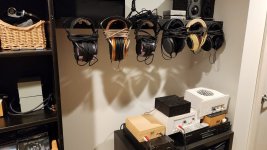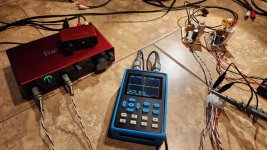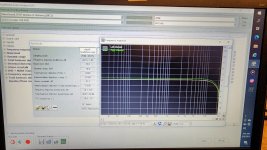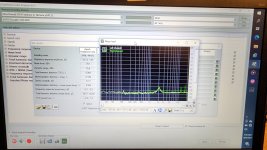Hugh, so in the end what transistors do you suggest using? Bc550 and 2sa1837? Or mje350, tip31, what one?Adason,
How are you doing with your new headphone amp?
HD
I would suggest BC550C and 2SA1837.
This makes a very quiet, transparent and dynamic HPA.
HD
This makes a very quiet, transparent and dynamic HPA.
HD
Ok, 2-3 hours and its done. Working from first power on. So far positive, sound is very promising. Negative, small click when you plug and unplug headphones since its cap coupled.
Will work on it.
Powered by 24VDC, using well regulated variable supply +/_12 VDC. It runs hot, but not too hot. May lower final power supply slightly.
Nice sound so far. No measurements done, may do quick distortion test later. Volume at 1/3 is terribly loud, yet still clean, so plenty of power with 220/100 ohm resistors already. It would be cooking at 43/20 ohms.
(What about 3-5 watt version?)
Will work on it.
Powered by 24VDC, using well regulated variable supply +/_12 VDC. It runs hot, but not too hot. May lower final power supply slightly.
Nice sound so far. No measurements done, may do quick distortion test later. Volume at 1/3 is terribly loud, yet still clean, so plenty of power with 220/100 ohm resistors already. It would be cooking at 43/20 ohms.
(What about 3-5 watt version?)
Attachments
And that be.I would suggest BC550C and 2SA1837.
This makes a very quiet, transparent and dynamic HPA.
HD
I did not make pcb right now, its from other project (mic pre). Just had to improvize a little with some wires, as it was 3 transistor circuit. I already improvised on this pcb with hamptone circuit.
So far i used jvc gummies and ess headphones (came free with big ess heil tweeter). Have not tried any better headphones yet. I got many. I got pretty good sennheiser and hifiman, but that will have to wait till in box.
So far i used jvc gummies and ess headphones (came free with big ess heil tweeter). Have not tried any better headphones yet. I got many. I got pretty good sennheiser and hifiman, but that will have to wait till in box.
Attachments
Adason, place a resistor across the output terminals so that the cap remains discharged, maybe 1K or so.
Ok, here we go...
I connected my measurements laptop, its not perfect, but it will do. I measured at 878mVpkpk, or 315mVRMS, which is as loud as one could tolerate with sennheiser hd580 headphones. So i did not measure with pure resistor or open (10k res). Real use measurements.
Good news, bad news. Its output is flat, but there is rollof. Why? Distortion is nice, mostly second harmonic, but its higher than predicted.
Background noise is below 100dB, its quiet.
I connected my measurements laptop, its not perfect, but it will do. I measured at 878mVpkpk, or 315mVRMS, which is as loud as one could tolerate with sennheiser hd580 headphones. So i did not measure with pure resistor or open (10k res). Real use measurements.
Good news, bad news. Its output is flat, but there is rollof. Why? Distortion is nice, mostly second harmonic, but its higher than predicted.
Background noise is below 100dB, its quiet.
Attachments
I did put 10k there...will try lower.Adason, place a resistor across the output terminals so that the cap remains discharged, maybe 1K or so.
... remains charged!so that the cap remains discharged
Without the resistor the charge vanishes and both cap leads are the same voltage, so no charge.
Adason, where does it roll off, HF or LF. If LF then increase capacitance say 10X if HF then bypass the electrolytic with 1uF film.
I attached images, its obvious that rollof is at top. Will try bypass mp cap. But its a minor thing...
I have HD595 in the cupboard and I think they are essentially the same as your 580s, just a cream colour and I also find that they roll-off at the high end, maybe our ears are rolling off. I am 70 in the shade.
I use equaliser APO and bump my HF up by about 2 dB to regain the sparkle. My everyday headphone is HD600 which has a bit of lift over the 595 at the top end.
I'm currently working on a headphone amplifier that may be of interest to some, It is a little more complex but worth it.
It's a strange all in phase design with a single transistor handling both feedback and voltage gain, It's still on the bench being tweaked but distortion will certainly be less than 0.01% just before clipping. Though very low distortion was not the end goal for this project.
It's more aimed at low-impedance phones as the output will be 4V less than the rail voltage, but could always be ran at a higher voltage to compensate.
I like experimenting and trying something different and non conventional things, I've listened to it as it is now and sounds very dynamic and clean. A great start.
It should be later on today I will report the schematic and some FFT's 🙂
👍
It's a strange all in phase design with a single transistor handling both feedback and voltage gain, It's still on the bench being tweaked but distortion will certainly be less than 0.01% just before clipping. Though very low distortion was not the end goal for this project.
It's more aimed at low-impedance phones as the output will be 4V less than the rail voltage, but could always be ran at a higher voltage to compensate.
I like experimenting and trying something different and non conventional things, I've listened to it as it is now and sounds very dynamic and clean. A great start.
It should be later on today I will report the schematic and some FFT's 🙂
👍
- Home
- Amplifiers
- Headphone Systems
- DIY Class A Headphone Amp suggestion






